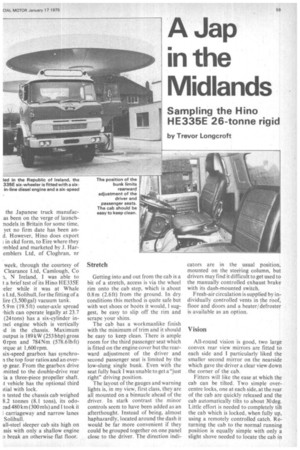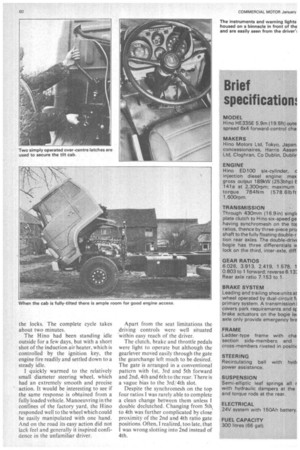A Jap in the Midlands
Page 61

Page 62

If you've noticed an error in this article please click here to report it so we can fix it.
Sampling the Hino HE335E 26-tonne rigid
by Trevor Longcroft Stretch Getting into and out from the cab is a bit of a stretch, access is via the wheel rim onto the cab step, which is about 08m (2.6 ft) from the ground. In dry conditions this method is quite safe but with wet shoes or boots it would, I suggest, be easy to slip off the rim and scrape your shins.
The cab has a workmanlike finish with the minimum of trim and it should be easy to keep clean. There is ample room for the third passenger seat which is fitted on the engine cover but the rearward adjustment of the driver and second passenger seat is limited by the low-slung single bunk. Even with the seat fully back J was unable to get a "just right" driving position.
The layout of the gauges and warning lights is, in my view, first class, they are all mounted on a binnacle ahead of the driver. In stark contrast the minor controls seem to have been added as an afterthought. Instead of being, almost haphazardly, located around the dash it would be far more convenient if they could be grouped together on one panel close to the driver. The direction indi cators are in the usual position, mounted on• the steeling column, but drivers may find it difficult to get used to the manually controlled exhaust brake with its dash-mounted switch.
Fresh-air circulation is supplied by individually controlled vents in the roof, floor and doors and a heater/ 'defroster is available as an option.
Vision All-round vision is good, two large convex rear view mirrors are fitted to each side and I particularly liked the smaller second mirror on the nearside which gave the driver a cleat view down the corner of the cab.
Fitters will like the ease at which the cab can be tilted. Two simple overcentre locks, one at each side, at the rear of the cab are quickly released and the cab automatically tilts to about 30 deg. Little effort is needed to completely tilt the cab which is locked, when fully up, using a remotely controlled catch. Returning the cab to the normal running position is equally simple with only a slight shove needed to locate the cab in the locks. The complete cycle takes about two minutes.
The Hino had been standing idle outside for a few days, but with a short shot of the induction air heater, which is controlled by the ignition key, the engine fire readily and settled down to a steady idle.
I quickly warmed to the relatively small diameter steering wheel, which had an extremely smooth and precise action. It would be interesting to see if the same response. is obtained from a fully loaded vehicle. Manoeuvring in the confines of the factory yard, the Hino responded well to the wheel which could be easily manipulated with one hand. And on the road its easy action did not lack feel and generally it inspired confidence in the unfamiliar driver. Apart from the seat limitations the driving controls were well situated 'within easy reach of the driver.
The clutch, brake and throttle pedals were light to operate but although the gearlever moved easily through the gate the gearchange left much to be desired. The gate is arranged in a conventional pattern with 1 st, 3rd and 5th forward and 2nd, 4th and 6th to the rear. There is a vague bias to the 3rd/4th slot.
Despite the synchromesh on the top four ratios I was rarely able to complete a clean change between them unless I double declutched. Changing from 5th, to 4th was further complicated by close proximity of the 2nd and 4th ratio gate positions. Often, I realized, too late, that I was wrong slotting into 2nd instead of 4th.
























































































































